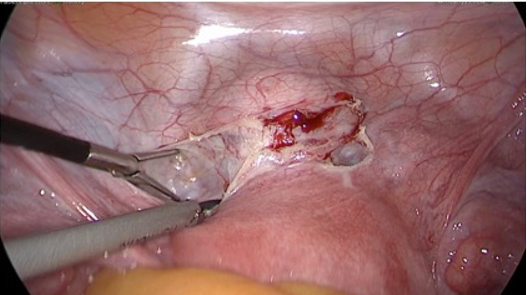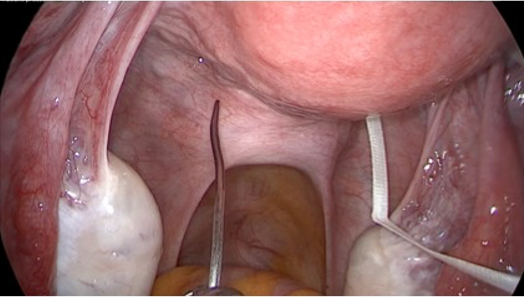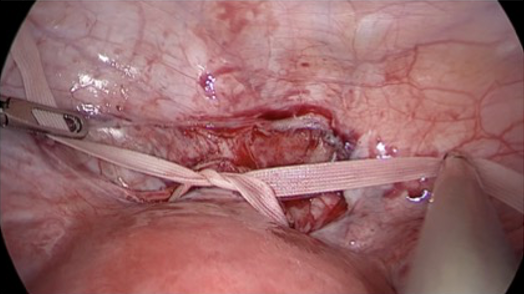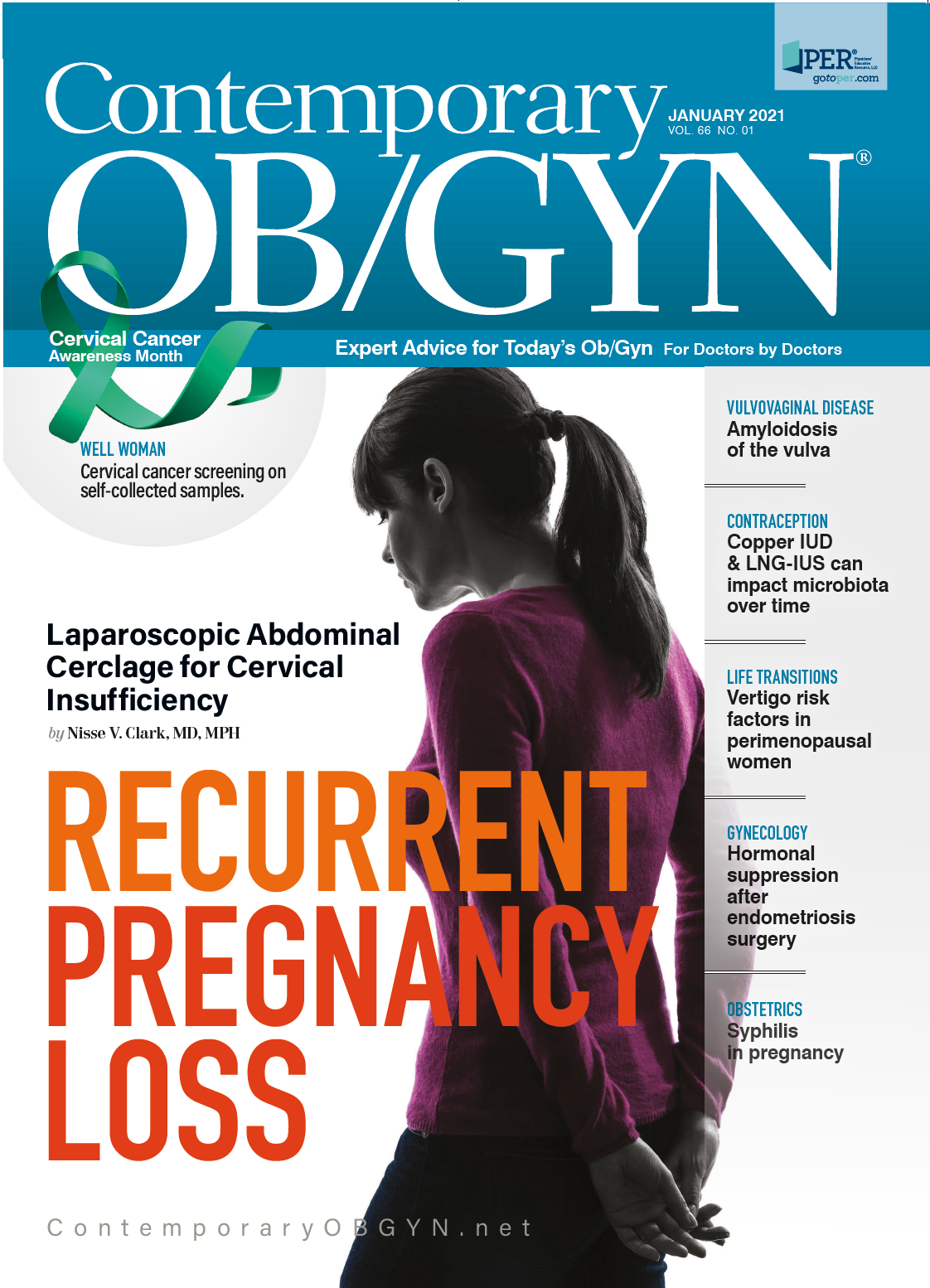Laparoscopic abdominal cerclage
Peer-reviewed
An effective option for refractory cervical insufficiency.
Introduction
Cervical insufficiency is defined as the inability of the uterine cervix to retain a pregnancy in the second trimester in the absence of clinical contractions, labor, or both.1 It is an important cause of spontaneous preterm birth and is estimated to affect up to 1% of pregnancies.2 The most common treatment for cervical insufficiency is a vaginal cerclage, a suture placed around the cervix vaginally to provide added support during the pregnancy.
In cases where a woman suffers a second trimester loss or preterm birth despite a well-timed and placed vaginal cerclage, termed refractory cervical insufficiency, an abdominal cerclage should be considered.
Newer evidence indicates an abdominal cerclage improves neonatal outcomes compared to a repeat vaginal cerclage in patients who have failed one prior vaginal cerclage.3 This finding suggests waiting until a woman has failed two prior vaginal cerclages before placing an abdominal cerclage may be too high a threshold.
Moreover, abdominal cerclages are increasingly performed using a laparoscopic approach, often prior to pregnancy.15 Considering the numerous advantages of laparoscopy compared to laparotomy for all gynecologic procedures, laparoscopic abdominal cerclage should be considered for refractory cervical insufficiency.
When an abdominal cerclage should be considered
The abdominal cerclage was first described by Benson and Durfee in 1965 for women with extreme cervical shortening.4 The most common indication for an abdominal cerclage today is at least one prior failed vaginal cerclage (despite appropriate timing and placement of the vaginal cerclage), or inability to place a vaginal cerclage.
The procedure entails placing a suture intraperitoneally at the level of the internal os, a technique that is believed to provide greater structural integrity to the cervix and potentially avoid vaginal contamination.5
The two largest studies-to-date evaluating abdominal cerclage outcomes have demonstrated very high neonatal survival rates (defined as the percent of pregnancies with neonates surviving until hospital discharge, exclusive of first trimester losses).6,7
The first was a large retrospective study including 300 women who underwent open or laparoscopic abdominal cerclage using their prior pregnancy as a control.6 The neonatal survival rate was 98% and the average gestational age at delivery was 37 weeks compared to 24 weeks in the prior pregnancy. The second study included 225 women who underwent a laparoscopic abdominal cerclage and found a similarly high neonatal survival rate of 98.5%, with a mean gestational age at the time of delivery of 35 weeks.7 There was no comparison group in this study.
The first multicenter randomized control trial comparing abdominal and vaginal cerclage after only one prior failed vaginal cerclage was recently published.3 The study included 111 women with a single failed prior vaginal cerclage (defined as a loss or preterm birth between 14 and 28 weeks of gestation) randomized to either an open abdominal cerclage or repeat vaginal cerclage.
The study found that preterm birth before 32 weeks of gestation was only 8% in women randomized to an abdominal cerclage compared to 38% in women randomized to a repeat vaginal cerclage (P=.008). These findings suggest an abdominal cerclage may be effective after only one prior failed vaginal cerclage.
Obstetricians have often maintained a high threshold for placing an abdominal cerclage due to its perceived surgical risk and the need to perform a cesarean section for delivery when an abdominal cerclage is in place. While a cesarean section is very often necessary, surgical risk related to the cerclage itself is reduced when performed prior to pregnancy and using a laparoscopic approach.15
Advantages of a laparoscopic approach
Laparoscopic abdominal cerclage was first reported in 1998 by Lesser et al. and has been increasingly used since that time.8 Extrapolating the well-documented advantages of laparoscopy for hysterectomy and myomectomy, laparoscopic abdominal cerclage is likely to result in reduced blood loss, fewer wound complications, and a shorter recovery compared to open abdominal cerclage.
In fact, one cohort study demonstrated reduced blood loss and length of stay following robotic-assisted laparoscopic abdominal cerclage compared to an open procedure.9 In addition to the benefit of small incisions, laparoscopy allows for careful dissection around the uterine vessels, helping to avoid vascular injury.
Uterine vessel injury is a dreaded complication of abdominal cerclage, especially when performed during pregnancy. While complication rates for laparoscopic versus open abdominal cerclage have not been directly compared in the literature, reported rates are generally lower for the laparoscopic approach.10
Conversion to laparotomy can occur in up to 5% of laparoscopic cases and may be more likely to occur during pregnancy given the increased bleeding risk, enlarged uterus, and challenges with uterine manipulation.11 Other complications are rare with single reports of suture migration, suture erosion or uterine rupture with an abdominal cerclage in place.12,13,14
Success rates for laparoscopic abdominal cerclage are comparable to open abdominal cerclage, according to observational data. The largest systematic review was by Moawad et al. and included 1,844 women who underwent laparoscopic versus open abdominal cerclage (before or after conception) with no significant difference in neonatal survival rates between the groups (90% for the laparoscopic group and 91% for the open group, P=.8).15
Interestingly, when first trimester losses were excluded from the analysis (as these are unlikely to be related to the cerclage), women who underwent laparoscopic abdominal cerclage actually had a significantly greater neonatal survival rate (97% versus 90%, P<.01). Neonatal survival rates with laparoscopic abdominal cerclage have also tended to increase over time with improved surgical technique.10
Simultaneous with a trend toward laparoscopic placement is a trend toward preconception abdominal cerclage placement.
This shift is likely due to a couple factors: 1) a less-invasive, lower-risk laparoscopic approach may be more acceptable as a preventative measure prior to confirmation of pregnancy, and 2) laparoscopy is generally more feasible in the nongravid state when the uterus is not enlarged and a manipulator can be placed.
Preconception abdominal cerclage, regardless of the surgical approach, also avoids the risk of perioperative miscarriage (estimated to occur in 1-3% of postconception abdominal cerclages).15 Literature comparing pre versus postconception abdominal cerclage is limited to observational data and often bias in that a disproportionate number of preconception abdominal cerclages are performed laparoscopically as compared to postconception abdominal cerclages which are most often performed abdominally.
A systematic review by Tulandi et al. analyzed 678 women who underwent laparoscopic and open abdominal cerclage outcomes separately, showing no difference in the rate of third-trimester delivery or live birth between pre versus postconception abdominal cerclage for either method.16
A cohort study of 161 women by Dawood and Farquharson did show a greater likelihood of delivery beyond 34 weeks with pre versus postconceptional abdominal cerclage (90% versus 74%, P=.02).17 Most conclude that preconception abdominal cerclage placement carries lower surgical and obstetric risk.
Laparoscopic abdominal cerclage technique
Several techniques for laparoscopic abdominal cerclage are described in the literature.18,19 In general, the procedure starts with standard laparoscopic positioning and port placement using either a conventional or robotic-assisted set-up.
Port placement is at the discretion of the surgeon though should consider uterine size and allow the surgeon to tie a strong knot with two hands. When the procedure is performed prior to pregnancy, a uterine manipulator is placed to aid with dissection and suture placement. The dissection begins by opening the vesicouterine peritoneum overlying the internal os (Figure 1).
Figure 1

This helps to reflect the bladder caudad and delineate the uterine vessels anteriorly. A nonabsorbable suture, most commonly a double-armed 5-mm Mersilene polyester tape with CTX or BP-1 needles is used. The needles can be straightened beforehand to facilitate trocar passage and ease suture placement.
Each needle is then passed between the uterine vessels and the cervix either anteriorly or posteriorly, with the final knot location depending on the suture type (double-arm versus single-arm) and insertion point. For anterior knot placement, the uterosacral ligaments provide a useful reference, with the needles inserted just above the insertion of the uterosacral ligaments on either side (Figure 2).
Figure 2

While passing the needle with one hand, it can be helpful to control the uterine manipulator with the other hand, ensuring placement of the suture between the uterine vessels and cervical stroma while simultaneously visualizing the needle’s entry and exit point.
Care should be taken not to deviate laterally which risks uterine vessel injury or deviate medially into the cervical stroma which can weaken the cerclage. Once the suture is placed and manipulator removed, the first knot is tightly secured and a total of six square knots placed (Figure 3).
Figure 3

Nonabsorbable suture such as silk can be secured to each suture end to aid in knot identification during future removal. The overlying peritoneum can then be closed if desired.
How and when to remove an abdominal cerclage
Given the risk of cervical injury or obstructed labor with an abdominal cerclage in place during labor, an elective cesarean section is typically performed at the time of delivery. The cerclage can be removed during the cesarean section or left in place for a future pregnancy.
A small study of 22 women with a laparoscopic abdominal cerclage retained from a prior pregnancy found a neonatal survival rate of 86% in the second pregnancy and 100% in the third pregnancy.20 In the event of previable fetal loss, a dilation and evacuation can be performed with the abdominal cerclage in-situ.
This has been performed without major complication up to 19 weeks of gestation.21 The cerclage can also be removed laparoscopically before dilation and evacuation and has been described in a single case report at 19 weeks of gestation.22
A novel technique using an anterior or posterior colpotomy and the assistance of a hysteroscope to cut and remove the stitch has been reported up to 23 weeks of gestation.23 If this is feasible at later gestational ages, a cesarean section could potentially be avoided in some viable pregnancies.
Conclusion
In summary, laparoscopic abdominal cerclage is a highly effective option for refractory cervical insufficiency with obstetric outcomes comparable to an open abdominal cerclage. The minimally invasive approach reduces surgical risk, especially when performed prior to conception.
Given new evidence favoring an abdominal cerclage over a repeat vaginal cerclage in women who have failed one prior vaginal cerclage, laparoscopic abdominal cerclage could be strongly considered for women with refractory cervical insufficiency.
Increased surgical experience and promising advances in the management of pre-viable pregnancy loss with an abdominal cerclage in-situ suggest that laparoscopic abdominal cerclage is a low-risk option for appropriate candidates.
__
References
- Rust O, Odibo A; American College of Obstetricians and Gynecologists. Practice Bulletin: Cerclage for the Management of Cervical Insufficiency. Number 142, February 2014.
- Ludmir J. Sonographic detection of cervical incompetence. Clin Obstet Gynecol. 1988;31:101-9.
- Shennan A, Chandiramani M, Bennett P, et al. MAVRIC: A Multicentre Randomised Controlled Trial of Transabdominal Versus Transvaginal Cervical Cerclage. Am J Obstet Gynecol. 2020 Mar;222(3):261.e1-261.
- Benson RC, Durfee RB. Transabdominal cervicouterine cerclage during pregnancy for the treatment of cervical incompetency. Obstet Gynecol. 1965;25:145-55.
- Debbs RH, DeLa Vega GA, Pearson S, Sehdev H, Marchiano D, Ludmir J. Transabdominal cerclage after comprehensive evaluation of women with previous unsuccessful transvaginal cerclage. Am J Obstet Gynecol. 2007;197:317.e1-4.
- Foster TL, Moore ES, Sumners JE. Operative complications and fetal morbidity encountered in 300 prophylactic transabdominal cervical cerclage procedures by one obstetric surgeon. J Obstet Gynaecol. 2011;31:713-7.
- Ades A, Parghi S, Aref-Adib M. Laparoscopic transabdominal cerclage: Outcomes of 121 pregnancies. Aust N Z J Obstet Gynaecol. 2018;58:606-11.
- Lesser KB, Childers JM, Surwit EA. Transabdominal cerclage: a laparoscopic approach. Obstet Gynecol. 1998;91:855-6.
- Smith RB, Brink J, Hu C, Gerkin R, Perlow JH, Mourad J. Robotic Transabdominal Cerclage vs Laparotomy: A Comparison of Obstetric and Surgical Outcomes. J Minim Invasive Gynecol. Jul-Aug 2020;27(5):1095-1102.
- Clark NV, Einarsson JI. Laparoscopic abdominal cerclage: a highly effective option for refractory cervical insufficiency. Fertil Steril. 2020 Apr;113(4):717-722.
- Burger NB, Brölmann HA, Einarsson JI, Langebrekke A, Huirne JA. Effectiveness of abdominal cerclage placed via laparotomy or laparoscopy; systematic review. J Minim Invasive Gynecol. 2011;18:696-704.
- Xu J, Wang L, Yang W, Zhang Y. Intravesical invasion of a Mersilene tape and secondary stone formation. Int Urogynecol J. 2019 Oct;30(10)1775-7.
- Hawkins E, Nimaroff M. Vaginal erosion of an abdominal cerclage 7 years after laparoscopic placement. Obstet Gynecol. 2014;123:420-3.
- Dandapani M, Pflugner LP, Fanning NS. Uterine Rupture at Term in a Patient With Abdominal Cerclage. Obstet Gynecol. 2019;133(5):940-942.
- Moawad GN, Tyan P, Bracke T, et al. Systematic Review of Transabdominal Cerclage Placed via Laparoscopy for the Prevention of Preterm Birth. J Minim Invasive Gynecol. 2018;25:277-86.
- Tulandi T, Alghanaim N, Hakeem G, Tan X. Pre and post-conceptional abdominal cerclage by laparoscopy or laparotomy. J Minim Invasive Gynecol. 2014;21:987-93.
- Dawood F, Farquharson RG. Transabdominal cerclage: preconceptual versus first trimester insertion. Eu J Obstet Gynecol Reprod Bio. 2016;199:27-31.
- Sukur YE, Saridogan E. Tips and tricks for laparoscopic interval transabdominal cervical cerclage; a simplified technique. J Turk Ger Gynecol Assoc. 2019 Nov 28;20(4):272-4.
- Smith AV, Cabrera R, Zomer MT, Ribeiro R, Talledo R, Kondo W. Laparoscopic Transabdominal Cerclage for Cervical Incompetence: A Feasible and Effective Treatment in 10 Steps. J Minim Invasive Gynecol. Jul-Aug 20200;27(5):1025-6.
- Ades A, Hawkins DP. Laparoscopic Transabdominal Cerclage and Subsequent Pregnancy Outcomes When Left In Situ. Obstet Gynecol. 2019;133:1195-8.
- Dethier D, Lassey SC, Pilliod R, Einarsson JI, McElrath T, Bartz D. Uterine evacuation in the setting of transabdominal cerclage. Contraception. 2020 Mar;101(3):174-7.
- Carter JF, Savage A, Soper DE. Laparoscopic removal of abdominal cerclage at 19 weeks’ gestation. JSLS. 2013;17:161-3.
- Burger NB, van ‘t Hof EM, Huirne JAF. Removal of an Abdominal Cerclage by Colpotomy: A Novel and Minimally Invasive Technique. J Minim Invasive Gynecol. 2020 May 28:S1553-4650(20)30254-5.

S4E1: New RNA platform can predict pregnancy complications
February 11th 2022In this episode of Pap Talk, Contemporary OB/GYN® sat down with Maneesh Jain, CEO of Mirvie, and Michal Elovitz, MD, chief medical advisor at Mirvie, a new RNA platform that is able to predict pregnancy complications by revealing the biology of each pregnancy. They discussed recently published data regarding the platform's ability to predict preeclampsia and preterm birth.
Listen
sFLT1/PLGF ratio may improve risk stratification for birth outcomes
March 17th 2025A recent study suggests that the soluble fms-like tyrosine kinase 1 to placental growth factor ratio can help predict clinical deterioration, intrapartum fetal distress, and mode of delivery, offering valuable insights for patient counseling and labor management.
Read More
